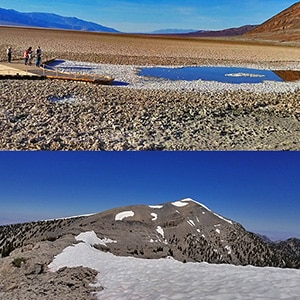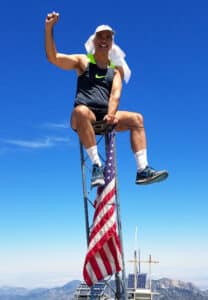Elevations Range from 282ft Below Sea Level at Bad Water to 11,900ft on Charleston Peak
For Maximum Enjoyment and Safety, Select the Adventure that Best Fits the Following Criteria

When you’re planning your adventure by elevation, think “Nomad Tribe”. The ancient nomad tribes migrated to the higher elevations in the warmer seasons and to the lower elevations in the cooler seasons. In spite of advances in sporting gear, I find it most comfortable and am able to cover more ground, far easier by following this ancient practice. One of the unique wonders of the Las Vegas area is that during the year you can migrate between the lowest elevation in the Western Hemisphere, Bad Water in Death Valley (-282ft below sea level) to the highest elevation on Charleston Peak (11,019ft above sea level)! But these elevations are very difficult and even dangerous during the wrong season.
High elevation adventures bring spectacular views during the 210 sunny days each year in the Las Vegas area, only surpassed by Phoenix (211 sunny days) and Yuma (242 sunny days). So, on any given day you have over a 2 out of 3 chance of being in the sun! However, there are the following challenges:
The Sun: The downside of the sun is that at the higher elevations, there is less atmosphere blocking skin-damaging sun rays. The lighter your skin type, use a higher level of sunscreen. I am of Mediterranean descent and have used sunscreen 4 for years. However, that is pressing the limits and I would not recommend that low a number. You’re better off with 20 or above. If you’re of Northern European descent inch up closer to 30-50. And, be sure to wear good sun glasses, especially if there’s snow on the ground which can cause blinding, eye-damaging conditions. The sun can also exhaust you making you feel like a piece of wilted lettuce. I wear a white runner’s cap with a white cloth descending under the cap, covering my ears and neck, creating a kind of Arab headdress look. This creates cool shade even when the hot sun is beating down and conserves energy.
Challenges of High Elevation Adventures (Continued)
The Cold: As you ascend in elevation, you’re working up a sweat. Simultaneously it’s getting cooler. During the colder seasons when the higher elevations are below freezing, that sweat can become very cold and create hypothermia. Even in the warmer seasons, it can snow on Charleston Peak in mid-July! My strategy is not to try to stay warm or cool, but to always shoot for a state of “equilibrium”. If you dress too warm on a cold day at the beginning of your adventure, you’ll overheat and sweat as you ascend and become exhausted. Rather, bring multiple lighter layers of clothing that you can add and remove as the temperature changes. I dress for how I will feel after the first mile based on my predicted exertion, not how I feel just having emerged from the car and standing at the trailhead. Don’t wear cotton. Cotton collects moisture. Wear polyester microfiber. When it’s very cold in the higher elevations, a cap can warm your body better than extra clothing since heat is mostly lost through the head. Sled dogs overheat at 30 degrees and run best at 0 degrees. So don’t overdress and overheat!
Oxygen: As you ascend, oxygen loss in the atmosphere creeps in. For example, at 2,000ft, close to the altitude of the Las Vegas Strip, the effective oxygen percentage is 19.4% . At 12,000ft, close to the altitude of the summit of Charleston Peak, the effective oxygen percentage is 13.2%. This represents a loss of about 6% effective oxygen. To put things simply, there is roughly 1/3rd less effective oxygen at the summit of Charleston Peak compared to the effective oxygen on the Las Vegas Strip! Therefore, you have 1/3rd less oxygen supply to your blood and muscles and can expect the demand on your effort to advance every step to increase by 1/3rd. Couple this by the fact that you are likely ascending a steep incline which further increases the energy demand. You can expect headache, exhaustion and a weak feeling. I your head is not covered, the sun is beating down and you’re not hydrating properly expect much more of the same!
Challenges of High Elevation Adventures (Continued)
How do I counter this loss of oxygen at high altitude?
At the beginning of the high altitude season, select an adventure around 6,000ft in elevation. Turtlehead Peak in Red Rock Park is a good example. After a couple weeks on Turtlehead Peak go for 7,000ft. Gass Peak, Damsel Peak the Bristlecone Pine Trail and Potosi Mountain are good examples. Then graduate to 9,000ft. Cockscomb Ridge, Raintree are good examples. Then 10,000ft. (Fletcher Peak). Then 11,000ft. (Griffith Peak, Lee Peak). Then you’re ready to enjoy Mummy Mountain (11,520ft) and Charleston Peak (11,919ft)!
These are just a few examples of adventures at various altitudes. You can see the altitude of every adventure on this site by viewing the adventure thumbnail images on the overview pages for each wilderness area.
Low altitude presents the problems of heat and hydration during the hot seasons. These are covered on the Season and Temperature page.



Return often to experience one new adventure each week! From the home page scroll to “Most Recent Adventures“. More about David Smith…
The trail adventures on this website require proper conditioning, preparation and safety precautions. There are many factors beyond our control including weather conditions, unstable ground, loose rocks, insects and snakes, people you may encounter, your own level of physical conditioning, the potential of getting lost just to mention a few. While this site offers guidance, helpful tips, direction and training, the reader assumes full responsibility for whatever may occur during their trail adventure. Have fun and be safe!